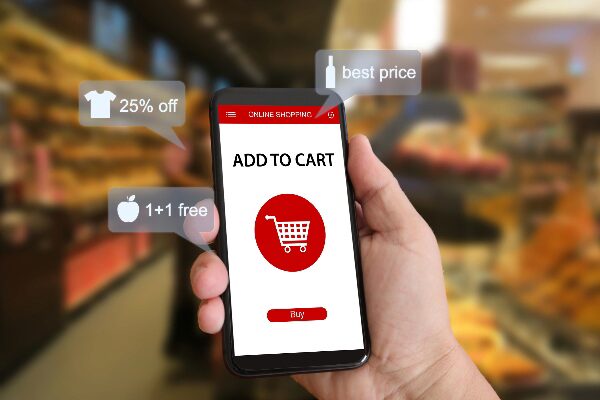 To deliver an exceptional customer experience today, retailers need to embrace the technology channels where their customers spend their time. Today, that’s often online. Top retailers in the U.S., including Walmart and Costco, offer engaging online experiences in addition to in-store shopping. Retailers like Amazon sell primarily via e-commerce.
To deliver an exceptional customer experience today, retailers need to embrace the technology channels where their customers spend their time. Today, that’s often online. Top retailers in the U.S., including Walmart and Costco, offer engaging online experiences in addition to in-store shopping. Retailers like Amazon sell primarily via e-commerce.
Digital technology can help brick-and-mortar and e-commerce retailers provide better customer service while improving sales and forecasting. Following are four examples of retail digital transformation that are helping retailers grow their businesses.
1. Store-Branded Applications
Digital apps use precious real estate on customer devices and help a brand stay at top of mind each time the app is opened on the screen.
Mobile applications provide a space for customers to:
- Find what they want in a brand
- Get coupons
- Connect with customer service
- Read company news
Target’s mobile app
Target, another top 10 largest U.S. retailer, built a free mobile application that effectively engages customers in the shopping experience. The Target app enables customers to:
- Organize shopping lists
- Sign up for emailed coupons
- Search for items in stock in stores
- Pinpoint the shopping aisles where items are located
- Learn which items are on sale in stores
- Browse products in the app and get instant coupons
A practical app feature allows Target customers to scan their physical store receipts using the app and earn cash-back rewards for in-store and in-app purchases. The app also helps facilitate contactless shopping by offering at-store pickup and home delivery.
Gathering customer data
To sign up, most retail apps require the customer to provide information that may include:
- Name
- Birthday
- Email address
- Phone number
- Home address
This enables retailers to gather valuable customer data and send personalized offers by email or the postal service.
2. Personalization
Retailers are using digital technology to build stronger personal relationships with customers and to make targeted offers. According to the Sailthru Retail Personalization Index, 71% of consumers say personalization matters. Consumers also tend to shop more with brands that personalize their communications. Four out of five consumers will share some personal information in exchange for personalized offers and deals.
Tracking consumer purchases and upselling
Retailers that track consumer purchases can send related product offers to consumers by email. Online e-commerce shops can suggest “you might also like” items that pop up before the customer makes a final selection or pays.
Food delivery platform Uber Eats tempts customers with photos of related food items to purchase in addition to the main food item in an effort to increase the order.
Fashion retailer Express personalizes communications by emailing customers suggestions for accessory items, for example, that complement a newly purchased Express dress.
In these ways, brands seek to increase opportunities to sell more products, while providing the customer with suggestions on complementary food and style.
Loyalty programs
Personalization extends to customer loyalty programs that enable brands to send coupons related to past purchases or offer discounts for similar products. Brands can also give customers the ability to personalize the rewards they earn in a loyalty program by letting them choose how they spend earned points or cash back rewards.
3. Virtual Shopping Experiences
More brands are expanding into virtual shopping worlds such as the metaverse. Nike and Gucci have created metaverse shopping experiences that offer unique virtual collectibles.
Meanwhile, Walmart has moved into metaverse capabilities through the gaming platform Roblox, with possible future plans to transition virtual experiences into real-world purchases. TV network Bravo has a virtual bazaar featuring items sold by the channel’s star personalities.
According to the 2022 Obsess survey The Metaverse Mindset: Consumer Shopping Insights, 70% of people who have browsed a virtual store bought something. Retailers are also integrating into virtual worlds by offering unique branded items in video games. Fashion brand Longchamp Paris offered a virtual backpack for Pokémon Go avatars to launch a Paris Fashion Week.
A growing virtual reality market
Statista projects the global virtual reality market will increase from less than $12 billion in 2022 to more than $22 billion by 2025. It’s up to retailers to determine how significant virtual reality is to their customers, but more consumers are using it more often.
4. Augmented Reality
Augmented reality technology creates an immersive shopping experience for customers online and in stores by bringing virtual elements into a customer’s view of the real world.
Brands can use augmented reality to help consumers “try before they buy.” Eyeglasses retailer Warby Parker can virtually show consumers what various types of eyeglass frames would look like on their faces. Meanwhile, makeup brand Sephora’s Virtual Artist augmented reality tool lets customers virtually try on lipstick colors and other makeup shades after users upload a selfie.
Augmented reality can also be used to create unique in-store displays. At the Downtown Disney store in Orlando, shoppers can hold a Lego box in front of a screen with augmented reality capabilities and see what the assembled toy would look like. Futuristic features like these can attract visitors into physical stores while helping to drive sales.
Digital Technology Helps Create an Omnichannel Shopping Experience
Digital technology is transforming the ways brands are building relationships with customers in helping to create an omnichannel shopping experience. In-store and online retailers can capture customer data to learn more about buying patterns and improve personalization on offers. Augmented reality technology can enhance the shopping experience while brands expand their presence and connect with more customers in virtual worlds like the metaverse.
To learn more about retail digital transformation and how your business can adapt, sign up for the four-week Leadership in the Age of Digital Disruption online certificate from Wharton Online. Also be sure to learn about our full Digital Marketing Certificate Program.



